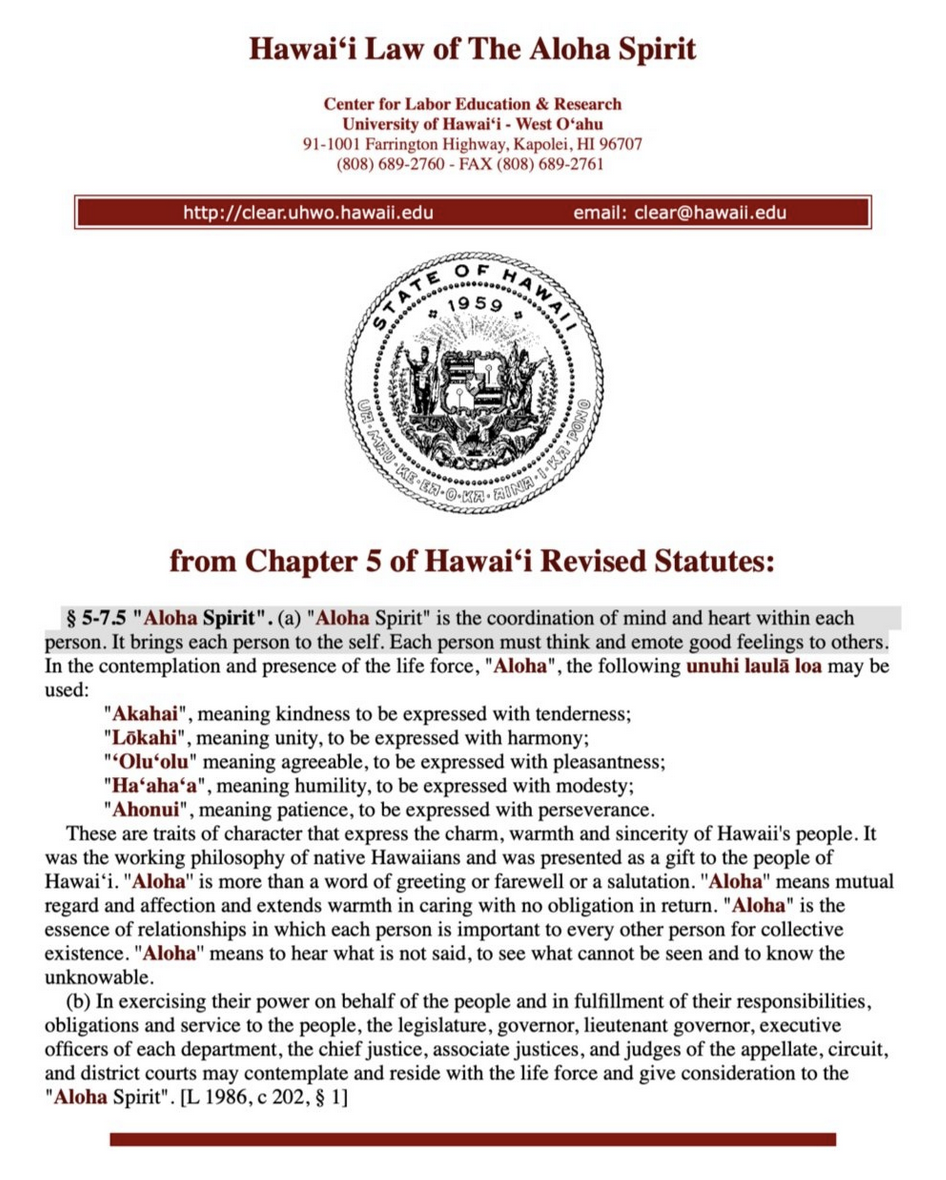The primary author and driving force behind Hawaiʻi’s Aloha Spirit law (HRS §5-7.5) was Aunty Pilahi Pakī, a respected Hawaiian philosopher, teacher, and cultural practitioner from Maui. She introduced the foundational concepts of the law during the 1970 Governor’s Conference on the Year 2000, where she articulated a vision of aloha as a guiding principle for governance and daily life.
Aunty Pilahi believed that the world would one day look to Hawaiʻi for healing and that aloha would be the remedy. Her advocacy culminated in the law’s enactment in 1986, embedding the values of kindness (akahai), unity (lokahi), agreeableness (ʻoluʻolu), humility (haʻahaʻa), and patience (ahonui) into the state’s legal framework.
While the law is symbolic and lacks enforcement mechanisms, it serves as a moral compass for public officials and a cultural touchstone for Hawaiʻi’s residents. Aunty Pilahi’s foresight ensured that the essence of ALOHA remains integral to Hawaiʻi’s identity and governance.
The law defines the “Aloha Spirit” not as a loose cultural idea but as a codified value system that guides how state officials and citizens are meant to treat one another. It’s essentially a mandate to govern with compassion, kindness, and respect, drawing from the traditional Hawaiian understanding of ALOHA as more than just a greeting – it’s a philosophy of being.
The Statute Reads:
“Aloha is the essence of relationships in which each person is important to every other person for collective existence.”
It also notes that the ALOHA Spirit involves “mutual regard and affection,” and it requires those in government to “contemplate and reside with the life force and essence of aloha” when carrying out their duties.
What Power It Has:
Legally speaking, this is not an enforceable law in the usual sense. No one is going to jail or paying fines for violating the ALOHA Spirit. It’s what’s known as a “guiding principle” statute – a soft law or aspirational law.
However, it does have real influence in the following ways:
- Judicial Interpretation: Courts can (and sometimes do) cite it when interpreting ambiguous legal cases or government behavior – especially in issues around community relations, cultural preservation, and respectful governance.
- Government Conduct: It functions as a reminder, or even a moral obligation, for public servants to act with aloha – particularly when dealing with indigenous rights, environmental matters, or social justice.
- Cultural Assertion: It’s a form of cultural codification – a subtle but powerful move to ensure that native Hawaiian values aren’t dismissed or overridden by mainland bureaucratic norms.
Critical Perspective:
- Strength: Embeds Hawaiian worldview into the legal framework; a rare acknowledgment of indigenous philosophy in law.
- Weakness: Without enforcement mechanisms, it relies on goodwill. If a public servant acts without aloha, there’s no direct consequence unless another law is violated.
- Interpretive Leverage: Activists and cultural advocates can use it to challenge state behavior, but it’s more rhetorical than regulatory.
Strategic Use:
If you’re ever invoking this law whether in advocacy, education, or negotiation, it would be wise not to frame it as a weapon. Frame it as a sacred compass that the State of Hawaiʻi itself has chosen to adopt. Use it to hold institutions accountable to their own stated values, especially in contexts involving land use, indigenous rights, or public health.
In short, the ALOHA Spirit law has no sharp teeth but it does have a spine. And in the right hands, that’s enough to make it matter.

